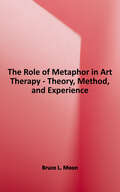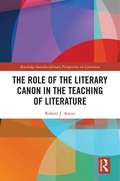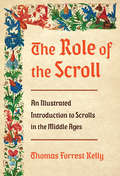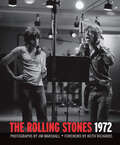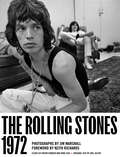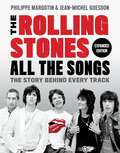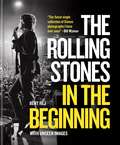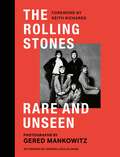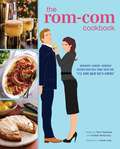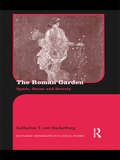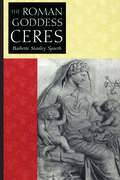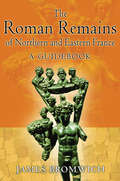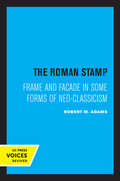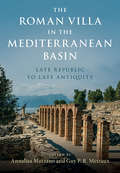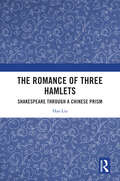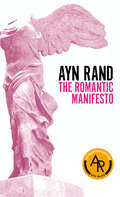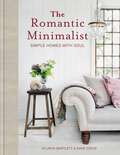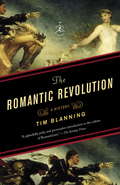- Table View
- List View
The Role of Metaphor in Art Therapy: Theory, Method, and Experience
by Bruce L. MoonPragmatic and poetic, this book is a tribute to the complexities and mysteries of working with people who are suffering and striving to tell their stories through expressive artistic processes. Its roots lay deep in encounters with children, adolescents, and adults who have come to the author for help over the last three decades. It is grounded in interactions with graduate art therapy students and encounters with important themes in life. This book makes no effort to affix particular meanings to the metaphors discussed in the clinical vignettes, but rather, suggests ways to listen and respond to metaphoric communications. In the methodology described in this book, ways to respond to clients’ metaphors are demonstrated by creating stories, poems, and visual artworks. Art therapy sessions are described, engaging in dialogues with clients and their artworks in an effort to invite both to share stories. The studio-based approach, where artists and art therapists work side-by-side making art, exploring transition issues, and listening metaphorically, is examined. In addition, the relevance of esthetics and empathy in looking at client artwork without judgment and responding to the client through art making is discussed. This excellent resource describes how to look at, listen to, and respond to the metaphors that artworks divulge.
The Role of Prototypes in Design Research: Overview and Cases Studies (SpringerBriefs in Applied Sciences and Technology)
by Silvia D. FerrarisThis book provides a theoretical framework for design researchers interested in developing their research work about and with prototypes. It describes prototypes' multiple definitions and possible functions in the multifaceted landscape of today's design research. Indeed, while the manufacturing and digital evolutions enable and require new types of advanced prototypes, the design evolution as an academic discipline continuously widens its perspectives, fields, and research methods, among which are the prototypes' applications, features, and purposes. The framework originates from an interpretation of these interrelated phenomena and a collection of case studies. Additionally, it defines those criteria that characterize the relation between the research (context, discipline, and general scope) and the prototype (nature and specific aims) and, altogether, it presents an overview of prototypes' roles in design research.
The Role of Today's Museum
by Clive Gray Vikki McCallThe Role of Today’s Museum provides a thorough investigation of what museums do and why. Arguing that museums are multifunctional institutions, the book examines the consequences of this for the services that museums provide, the publics to whom they are provided and the providers themselves. Adopting a wide perspective on understandings of the roles of museums and considering the different environments within which museums operate, Gray and McCall provide a new perspective on how transformations, as well as the gaps between intended policies and the actual work that is undertaken within museums, can be both identified and understood. By differentiating between social, economic and political visions and expectations of museums, the analysis in this book allows for a fuller understanding of what these organisations do and provide for their societies and the struggles and negotiations that surround their existence. The Role of Today’s Museum takes a critical, interdisciplinary approach to studying museums and museum policy. As a result, the book will be of interest to academics and students engaged in the study of museums, cultural policy, social policy, cultural sociology, public policy and cultural and political economy. Highlighting the gaps that exist between policy ideals and museum practices, the book also provides valuable insights to policy-makers and practitioners.
The Role of the Literary Canon in the Teaching of Literature (Routledge Interdisciplinary Perspectives on Literature)
by Robert AstonThis book investigates the role of the idea of the literary canon in the teaching of literature, especially in colleges and secondary schools in the United States. Before the term "canon" was widely used in literary studies, which occurred in the second half of 20th century when the canon was first seriously viewed as politically and culturally problematic, the idea that some literary texts were more worthy of being studied than others existed since the beginning of the discipline of the teaching of literature in the 1800s. The concept of the canon, however, extends as far back as to Ancient Greece and its meaning has evolved over time. Thus, this book charts the changing meaning of the idea of the literary canon, examining its influence specifically in the teaching of literature from the beginning of the field to the 21st century. To explain how the literary canon and the teaching of literature have changed over time and continue to change, this book constructs a theory of canon formation based on the ideas of Michel Foucault and the assemblage theory of Manuel DeLanda, illustrating that the literary canon, while frequently contested, is integral to the teaching of literature yet changes as the teaching of literature changes.
The Role of the Scroll: An Illustrated Introduction To Scrolls In The Middle Ages
by Thomas Forrest KellyA beautifully illustrated, full-color guide to scrolls and their uses in medieval life. Scrolls have always been shrouded by a kind of aura, a quality of somehow standing outside of time. They hold our attention with their age, beauty, and perplexing format. Beginning in the fourth century, the codex—or book—became the preferred medium for long texts. Why, then, did some people in the Middle Ages continue to make scrolls? In The Role of the Scroll, music professor and historian Thomas Forrest Kelly brings to life the most interesting scrolls in medieval history, placing them in the context of those who made, commissioned, and used them, and reveals their remarkably varied uses. Scrolls were the best way to keep ever-expanding lists, for example, those of debtors, knights, and the dead, the names of whom were added to existing rolls of parchment through the process of “enrollment.” While useful for keeping public records, scrolls could also be extremely private. Forgetful stage performers relied on them to recall their lines—indeed, “role” comes from the French word for scroll—and those looking for luck carried either blessings or magic spells, depending on their personal beliefs. Finally, scrolls could convey ceremonial importance, a purpose that lives on with academic diplomas. In these colorful pages, Kelly explores the scroll’s incredible diversity and invites us to examine showy court documents for empresses and tiny amulets for pregnant women. A recipe for turning everyday metal into gold offers a glimpse into medieval alchemy, and a log of gifts for Queen Elizabeth I showcases royal flattery and patronage. Climb William the Conqueror’s family tree and take a journey to the Holy Land using a pilgrimage map marked with such obligatory destinations as Jaffa, where Peter resurrected Tabitha, and Ramada, the city of Saint Joseph’s birth. A lively and accessible guide, The Role of the Scroll is essential reading—and viewing—for anyone interested in how people keep record of life through the ages.
The Rolling Stones 1972
by Jim MarshallA pictorial chronicle of the Stones’ classic summer concert tour from the Life magazine photographer who followed them—with a foreword by Keith Richards.In 1972, the Rolling Stones marked their first decade as a band with the release of Exile on Main St. and a summer concert tour of America that set new standards for magnificence in live performance. Covering the tour for Life magazine, photographer Jim Marshall captured indelible moments of the Stones in their glory onstage, as well as the camaraderie behind the scenes. Featuring a foreword by Keith Richards, this volume presents Marshall’s shots alongside dozens of never-before-seen frames. Stones fans will revel in this unprecedented look at one of the biggest rock bands of all time from the photographer who captured them best.“The stunning images in this collection show the Stones in all their strung-out Exile on Main Street-era splendor—recording in Los Angeles, chilling backstage and strutting across some very lucky concert stages.” —Rolling Stone
The Rolling Stones 1972 50th Anniversary Edition
by Nikki Sixx Jim Marshall Joel Selvin Anton CorbijnA deluxe edition of the seminal book that unites two legends of rock 'n' roll: Jim Marshall and the Rolling Stones. Now with new essays and never-before-seen proof sheets!The year 1972 brought together two legends of rock 'n' roll at the peaks of their careers: Jim Marshall and the Rolling Stones. Selected by LIFE magazine to photograph the Stones' EXILE ON MAIN ST. tour, Marshall had a week of unlimited access. The results are his now-iconic images of the band, onstage in their full glory and backstage in moments of unguarded camaraderie. Marshall's ability to capture the essential spirit of an artist and the transformative power of music is matched only by the Stones' larger-than-life energy. Fifty years after these photographs were taken, they retain the power to thrill and inspire.This definitive edition presents the images as they were meant to be seen: at a larger size and in the rich, high-contrast tones Marshall favored. The original content is enhanced with never-before-seen proof sheets and two new essays by photographer and film director Anton Corbijn and Nikki Sixx of Mötley Crüe. This is the ultimate, immersive experience of one of the greatest moments in music history.TWO MAJOR NAMES: This book showcases the confluence of two massive creative talents: the band that defined rock 'n' roll, and the photographer who best captured its spirit. Jim Marshall is renowned in the music photography world. His images will immerse you completely in the scene of 1972.MUST-HAVE FOR FANS: If you love music or photography, or you wish you could go back to the raw energy of the 1970s, this is the book for you.DELUXE COLLECTOR’S ITEM: Previously published in 2012, Marshall's Rolling Stones photographs now get the ultimate deluxe treatment. You can enjoy these beloved images at a larger size, printed high quality and high-contrast, and in a gorgeous hardcover that's perfect to gift or display.TWO ANNIVERSARIES: Summer 2022 is not only the 50th anniversary of the tour when these photos were taken, but also the 60th anniversary of the Stones' debut performance. Commemorate those historic moments with this stunning book.Perfect for:• Music fans and musicians• Photographers and photography buffs• Anyone nostalgic for the 1970s• Rolling Stones fans• Jim Marshall fans• Photography book collectors• Leica camera users• History buffs• Dads, moms, and grandparents
The Rolling Stones All the Songs Expanded Edition: The Story Behind Every Track
by Jean-Michel Guesdon Philippe MargotinComprehensive visual history of the "World's Greatest Rock & Roll Band" as told through the recording of their monumental catalog, including 29 studio and 24 compilation albums, and more than a hundred singles.Since 1963, The Rolling Stones have been recording and touring, selling more than 200 million records worldwide. While much is known about this iconic group, few books provide a comprehensive history of their time in the studio. In The Rolling Stones All the Songs, authors Margotin and Guesdon describe the origin of their 340 released songs, details from the recording studio, what instruments were used, and behind-the-scenes stories of the great artists who contributed to their tracks.Organized chronologically by album, this massive, 704-page hardcover begins with their 1963 eponymous debut album recorded over five days at the Regent Studio in London; through their collaboration with legendary producer Jimmy Miller in the ground-breaking albums from 1968 to 1973; to their later work with Don Was, who has produced every album since Voodoo Lounge. Packed with more than 500 photos, All the Songs is also filled with stories fans treasure, such as how the mobile studio they pioneered was featured in Deep Purple's classic song "Smoke on the Water" or how Keith Richards used a cassette recording of an acoustic guitar to get the unique riff on "Street Fighting Man."
The Rolling Stones In the Beginning: With unseen images
by Bent Rej"The photographs are amazing - the Stones are still practically children, messing around, pulling faces and writing the odd song."GQ"The finest single collection of Stones photographs I have ever seen" Bill WymanNEW, EXPANDED EDITION CONTAINING NEVER-BEFORE-SEEN PHOTOGRAPHS. In 1965 the Rolling Stones were big and about to be huge, when Bent Rej was given unprecedented access to a year in the eye of the rock 'n' roll storm, accompanying the band on its first full European outing: the Satisfaction tour. The Rolling Stones In the Beginning is Rej's collection of more than 300 intimate photographs of the band on stage, on the road and at home, documenting a year in the life of the Rolling Stones as they enjoyed their first taste of popular success.Long a fan favourite, this brand new edition offers an even closer look into the making of music history with images recently unearthed from Rej's archives.
The Rolling Stones In the Beginning: With unseen images
by Bent Rej"The photographs are amazing - the Stones are still practically children, messing around, pulling faces and writing the odd song."GQ"The finest single collection of Stones photographs I have ever seen" Bill WymanNEW, EXPANDED EDITION CONTAINING NEVER-BEFORE-SEEN PHOTOGRAPHS. In 1965 the Rolling Stones were big and about to be huge, when Bent Rej was given unprecedented access to a year in the eye of the rock 'n' roll storm, accompanying the band on its first full European outing: the Satisfaction tour. The Rolling Stones In the Beginning is Rej's collection of more than 300 intimate photographs of the band on stage, on the road and at home, documenting a year in the life of the Rolling Stones as they enjoyed their first taste of popular success.Long a fan favourite, this brand new edition offers an even closer look into the making of music history with images recently unearthed from Rej's archives.
The Rolling Stones Rare and Unseen: Foreword by Keith Richards, afterword by Andrew Loog Oldham
by Gered MankowitzFOREWORD BY KEITH RICHARDS'ICONIC... DAZZLING.'-MOJO'Gered was at one with the band. More than that, for that special time, he was in the band.'-ANDREW LOOG OLDHAM'He was a hell of a lot of fun. That's why he was a good photographer.'-MARIANNE FAITHFULLDelve into the unseen archive of iconic photographer Gered Mankowitz as he shares rare and newly discovered images of his time with the Rolling Stones, alongside his most iconic shots.Just a teenager, Mankowitz took some of the best-loved photographs of the Stones in their frantic, formative years. Now for the first time he looks beyond those famous images - unearthing frames that have never been seen before, plus those rarely used.Also featuring Gered's first-hand stories and a host of expert writers on the band and their music - including The Times' chief rock and pop critic Will Hodgkinson, Ben Sisario of the New York Times as well as academics, fashion writers and more - The Rolling Stones Rare and Unseen is a fresh look at the greatest story in rock 'n' roll.AFTERWORD BY ANDREW LOOG OLDHAM
The Rolling Stones Rare and Unseen: Foreword by Keith Richards, afterword by Andrew Loog Oldham
by Gered MankowitzFOREWORD BY KEITH RICHARDS'ICONIC... DAZZLING.'-MOJO'Gered was at one with the band. More than that, for that special time, he was in the band.'-ANDREW LOOG OLDHAM'He was a hell of a lot of fun. That's why he was a good photographer.'-MARIANNE FAITHFULLDelve into the unseen archive of iconic photographer Gered Mankowitz as he shares rare and newly discovered images of his time with the Rolling Stones, alongside his most iconic shots.Just a teenager, Mankowitz took some of the best-loved photographs of the Stones in their frantic, formative years. Now for the first time he looks beyond those famous images - unearthing frames that have never been seen before, plus those rarely used.Also featuring Gered's first-hand stories and a host of expert writers on the band and their music - including The Times' chief rock and pop critic Will Hodgkinson, Ben Sisario of the New York Times as well as academics, fashion writers and more - The Rolling Stones Rare and Unseen is a fresh look at the greatest story in rock 'n' roll.AFTERWORD BY ANDREW LOOG OLDHAM
The Rom Com Cookbook
by Tara TheoharisThe Rom Com Cookbook lets you "have what she's having" and so much more when you dish up your favorite rom-com movie moments with recipes inspired by Crazy Rich Asians, The Wedding Planner, Legally Blonde, Bridesmaids, Love Actually, The Princess Bride, and many, many more. Featuring meat-cute meals and meet-cute moments from over 50 films that you can share with friends, rivals, crushes, and unrequited lovers.Inspired by some of the greatest romantic comedies of all time, The Rom Com Cookbook brings you closer to your favorite movie moments with &“meat cute&” dishes, cocktail hour delights, the morning after breakfasts, long-term relationship entrees, break-up desserts, and holiday-inspired recipes. Perfect for dinner dates and movie marathons, this light-hearted, yet sassy, cookbook features easy-to-follow recipes even if you&’re a klutz in the kitchen. With ingredients found at your local grocery store, and notes for altering recipes for various dietary restrictions, these dishes are the perfect way to turn enemies into lovers! Bring your most cherished rom-coms into the kitchen with the beautiful food photography and original illustrations that bring a fresh take on scenes from your favorite films! FILM TO TABLE: Create Macadamia Nut Pancakes (50 First Dates), Moonstruck Eggs (Moonstruck), Nigel&’s Brie (10 Things I Hate About You), Blue Soup (Bridget Jones&’s Diary), Guilt-Free Pizza Margherita (Eat Pray Love), Cher-Proof Cookie Log (Clueless), Sam&’s Birthday Cake (Sixteen Candles), Thirty, Flirty, & Thriving Daiquiri (13 Going on 30), and many, many more delicious recipes! FALL IN LOVE: Featuring fabulous food photography that brings your favorite movie scenes right into your home and onto your dining room table! KITCHEN COMFORTS: Author Tara Theoharis creates approachable, easy-to-follow recipes for all skill-levels. Enter the kitchen with a fellow rom-com fan—Theoharis begins each recipe with an introduction to set the stage before you set the table . . . or the TV tray.
The Roman Garden: Space, Sense, and Society (Routledge Monographs in Classical Studies)
by Katharine T. von StackelbergThis innovative book is the first comprehensive study of ancient Roman gardens to combine literary and archaeological evidence with contemporary space theory. It applies a variety of interdisciplinary methods including access analysis, literary and gender theory to offer a critical framework for interpreting Roman gardens as physical sites and representations. The Roman Garden: Space, Sense, and Society examines how the garden functioned as a conceptual, sensual and physical space in Roman society, and its use as a vehicle of cultural communication. Readers will learn not only about the content and development of the Roman garden, but also how they promoted memories and experiences. It includes a detailed original analysis of garden terminology and concludes with three case studies on the House of Octavius Quartio and the House of the Menander in Pompeii, Pliny’s Tuscan garden, and Caligula’s Horti Lamiani in Rome. Providing both an introduction and an advanced analysis, this is a valuable and original addition to the growing scholarship in ancient gardens and will complement courses on Roman history, landscape archaeology and environmental history.
The Roman Goddess Ceres
by Barbette Stanley SpaethA thematic study of the Roman goddess of agriculture as represented in ancient culture from the prehistoric period to the Late Roman Empire.Interest in goddess worship is growing in contemporary society, as women seek models for feminine spirituality and wholeness. New cults are developing around ancient goddesses from many cultures, although their modern adherents often envision and interpret the goddesses very differently than their original worshippers did.In this thematic study of the Roman goddess Ceres, Barbette Spaeth explores the rich complexity of meanings and functions that grew up around the goddess from the prehistoric period to the Late Roman Empire. In particular, she examines two major concepts, fertility and liminality, and two social categories, the plebs and women, which were inextricably linked with Ceres in the Roman mind. Spaeth then analyzes an image of the goddess in a relief of the Ara Pacis, an important state monument of the Augustan period, showing how it incorporates all these varied roles and associations of Ceres. This interpretation represents a new contribution to art history. With its use of literary, epigraphical, numismatic, artistic, and archaeological evidence, The Roman Goddess Ceres presents a more encompassing view of the goddess than was previously available. It will be important reading for all students of Classics, as well as for a general audience interested in New Age, feminist, or pagan spirituality.
The Roman House in Britain
by Dominic PerringThis authoritative and original work sets the results of recent archaeological research in the context of classical scholarship, as it explores three main aspects of Romano-British buildings: * general characteristics of form and structure* the ways in which they were built and decorated* the range of activities for which they were designed. This evidence is then used to discuss the social practices and domestic arrangements that characterised Romano-British elite society. Fully illustrated, this volume is the essential guide to how houses were built, used and understood in Roman Britain.
The Roman Remains of Northern and Eastern France: A Guidebook
by James BromwichThis book provides a thorough, area by area companion to the region's wealth of monuments, excavations and artefacts, from Paris and Boulogne-sur-Mer to Strasbourg and Lyon. Over ninety sites are treated in detail, including major attractions such as the parc archéologique in Lyon and the amphitheatre at Autun, numerous local museums and secluded rural excavations.The guidebook combines a scholarly assessment of the area's Roman heritage, examining and interpreting the surviving remains, with practical visitor information such as directions to sites and opening hours. Comprehensively illustrated with photographs, maps and plans, it is a unique resource both for academic study and for visitors interested in the region's archaeological and historical background.
The Roman Stamp: Frame and Facade in Some Forms of Neo-Classicism
by Robert M. AdamsThis title is part of UC Press's Voices Revived program, which commemorates University of California Press’s mission to seek out and cultivate the brightest minds and give them voice, reach, and impact. Drawing on a backlist dating to 1893, Voices Revived makes high-quality, peer-reviewed scholarship accessible once again using print-on-demand technology. This title was originally published in 1974.
The Roman Villa in the Mediterranean Basin: Late Republic to Late Antiquity
by Annalisa Marzano Guy P. MétrauxThis volume offers a comprehensive survey of Roman villas in Italy and the Mediterranean provinces of the Roman Empire, from their origins to the collapse of the Empire. The architecture of villas could be humble or grand, and sometimes luxurious. Villas were most often farms where wine, olive oil, cereals, and manufactured goods, among other products, were produced. They were also venues for hospitality, conversation, and thinking on pagan, and ultimately Christian, themes. Villas spread as the Empire grew. Like towns and cities, they became the means of power and assimilation, just as infrastructure, such as aqueducts and bridges, was transforming the Mediterranean into a Roman sea. The distinctive Roman/Italian villa type was transferred to the provinces, resulting in Mediterranean-wide culture of rural dwelling and work that further unified the Empire.
The Romance of Three Hamlets: Shakespeare through a Chinese Prism
by Hao LiuThrough a metaphorical journey of Shakespeare in traditional Chinese theatre, using three Chinese opera productions of Hamlet as signposts, the book discusses the relationship between Shakespeare and Chinese theatrical traditions.A brief discussion of the Yue-opera Hamlet looks back at the role of Shakespeare in the Chinese discourse of renaissance and re-evaluation of traditions since the early twentieth century. A detailed analysis of the Peking-opera Hamlet shows what is lost and what is gained in the negotiation between Shakespeare and Chinese theatrical traditions, and why. The third Hamlet is an experimental Kun-opera production, leading to a discussion of the potential for Shakespeare and Chinese theatrical traditions to join hands and reach new depths of artistic expression.The book will attract researchers, students, and enthusiasts of Shakespeare, cross-cultural Shakespearean recreation, Chinese theatrical traditions, and comparative literature.
The Romantic Fiction Of Mills & Boon, 1909-1995 (Women's and Gender History)
by Dixon, Jay Jay Dixon.This study to analyzes romantic fiction's depiction of women as part of the broader history of ideas about women.; Given the success of the Mills & Boon romance, their portrayal of subjects like sex, love, marriage, class, motherhood and femineity are important cultural barometers and make interesting study.; The author shows how all these themes have an historical trajectory and how these novels have come to reflect feminist concerns.; Based on a study of over 1000 Mills & Boon romances the book provides analysis of plot types and shows how these have changed in response to women's own changing position within society.
The Romantic Manifesto
by Ayn RandIn this beautifully written and brilliantly reasoned book, Ayn Rand throws a new light on the nature of art and its purpose in human life. Once again Miss Rand eloquently demonstrates her refusal to let popular catchwords and conventional ideas stand between her and the truth as she has discovered it. The Romantic Manifesto takes its place beside The Fountainhead as one of the most important achievements of our time.
The Romantic Minimalist: Simple Homes with Soul
by Atlanta Bartlett Dave Coote'Atlanta and Dave's unique blend of nostalgic romanticism combined with a thoughtful approach to sustainability and slow living, makes this book a dream for anyone interested in how to live with vintage and antiques without succumbing to clutter or consumerism.'Paula Sutton - Hill House Vintage'A book for those who fall between the all-out riot that is maximalism and the rigidity of minimalism, the authors lead you gently down a middle path where it's about layering textures to create comfort and character without overwhelming the senses. If there is such a thing as mindful decorating this is it.' Kate Watson-Smyth - Mad About the House'Atlanta and Dave have a unique talent to build, rework and decorate properties with a functional and romantic flow. Using reclaimed and authentic elements is a signature of their work and creates charming and timeless homes.' Rachel Ashwell - Founder of Shabby Chic'Atlanta and Dave prove that their beautiful beachy aesthetic is easy to achieve in this stylish book, which is a celebration of pared back, timeless interiors. I'd love to live in every one.' Sarah Tomczak - Editor in Chief Red Magazine'I have admired Atlanta and Dave for many years! They stand as a true trailblazers in British vintage interiors. Her aesthetic exudes a sense of timeless beauty and sophistication.' Pearl LoweIn this timely interiors book, design duo Atlanta Bartlett and Dave Coote explore a new type of minimalism. The emphasis is on appreciating the imperfect, encouraging self-expression and never compromising on comfort.This new minimalism has romance and nostalgia at its heart. It celebrates the plain and simple things in life; loves old, time-worn treasures; shuns materialism in favour of sustainability and creates a home to soothe the soul. The book includes stunningly photographed case studies of homes, alongside chapters on topics ranging from working with colour and textiles, to sustainability and sourcing found objects from nature. This is the perfect manual for curating elegant and soothing living spaces.
The Romantic Minimalist: Simple Homes with Soul
by Atlanta Bartlett Dave Coote'Atlanta and Dave's unique blend of nostalgic romanticism combined with a thoughtful approach to sustainability and slow living, makes this book a dream for anyone interested in how to live with vintage and antiques without succumbing to clutter or consumerism.'Paula Sutton - Hill House Vintage'A book for those who fall between the all-out riot that is maximalism and the rigidity of minimalism, the authors lead you gently down a middle path where it's about layering textures to create comfort and character without overwhelming the senses. If there is such a thing as mindful decorating this is it.' Kate Watson-Smyth - Mad About the House'Atlanta and Dave have a unique talent to build, rework and decorate properties with a functional and romantic flow. Using reclaimed and authentic elements is a signature of their work and creates charming and timeless homes.' Rachel Ashwell - Founder of Shabby Chic'Atlanta and Dave prove that their beautiful beachy aesthetic is easy to achieve in this stylish book, which is a celebration of pared back, timeless interiors. I'd love to live in every one.' Sarah Tomczak - Editor in Chief Red Magazine'I have admired Atlanta and Dave for many years! They stand as a true trailblazers in British vintage interiors. Her aesthetic exudes a sense of timeless beauty and sophistication.' Pearl LoweIn this timely interiors book, design duo Atlanta Bartlett and Dave Coote explore a new type of minimalism. The emphasis is on appreciating the imperfect, encouraging self-expression and never compromising on comfort.This new minimalism has romance and nostalgia at its heart. It celebrates the plain and simple things in life; loves old, time-worn treasures; shuns materialism in favour of sustainability and creates a home to soothe the soul. The book includes stunningly photographed case studies of homes, alongside chapters on topics ranging from working with colour and textiles, to sustainability and sourcing found objects from nature. This is the perfect manual for curating elegant and soothing living spaces.
The Romantic Revolution
by Tim BlanningFrom the preeminent historian of Europe in the eighteenth and nineteenth centuries comes a superb, concise account of a cultural upheaval that still shapes sensibilities today. Long overshadowed by the contemporaneous American, French, and Industrial revolutions, the Romantic Revolution finally receives its due in Tim Blanning's bold and brilliant work.A rebellion against the rationality of the Enlightenment, a rejection of "the Academy" in favor of public opinion, Romanticism was a profound shift in expression that altered the arts and ushered in modernity, even as it championed a return to the intuitive and the primitive. Blanning describes its beginnings in Rousseau's novel La Nouvelle Héloïse, the biggest bestseller of the eighteenth century, a work that placed the creator--and not the created--at the center of aesthetic activity and led to the virtual worship of creative geniuses by the general public. Blanning reveals the glamorizing of artistic madness and suicide in Goethe's novel The Sufferings of Young Werther and the ballet Giselle; the role of sex as a psychological force in Friedrich Schlegel's novel Lucinde; the importance of mind-altering drugs to the fictional protagonist of Confessions of an English Opium Eater and to the composer Hector Berlioz in his Symphonie fantastique; and the use of naïve, dreamlike imagery in Goya's paintings of monsters, devils, and witches.Whether it was the new notion of "sex appeal" in the fames of Paganini, Liszt, and Byron, or the celebration of accessible storytelling in the novels of Walter Scott (the most popular writer of the day), The Romantic Revolution unearths the origins of ideas now commonplace in our culture. It is the best introduction to an essential time whose influence would far outlast the mechanistic "age of the railway" that, in the mid-nineteenth century, replaced it.From the Hardcover edition.
